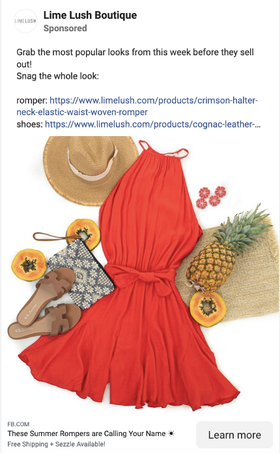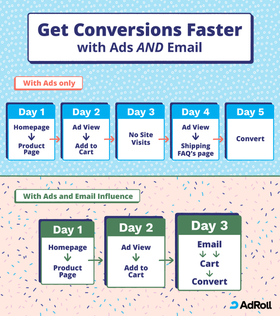AdRoll vs. MNTN
How do AdRoll and MNTN compare when it comes to features, pricing, pros, cons, and use cases? We’ve got the answers.
Read More
Do you ever find yourself in a situation where you think of the perfect retort, witty joke, or snarky comment… one day after the fact? Well, that happens to me (surprisingly often — I am hilarious on a delay).
Unlike your social life, your ecommerce store can achieve do-overs with prospective customers — all thanks to retargeting. Those visitors that make the questionable decision to leave without buying your amazing stuff? You can now send them targeted, engaging messages related to the products they viewed directly to their inbox, across the web, and on social networks to bring them back to your site.
However, to successfully turn your browser into buyers, you’ll need more than just the right tools. Here are three small, but significant, tips to implement into your marketing strategy.
When it comes to creating promotional messaging, it’s important to pay attention to what site visitor behavior is telling you about buying stages and shopping goals. Some visitors may spend a lot of time browsing products then leave without choosing anything. Other visitors may place items into a shopping cart but then abandon the checkout process. These behaviors — browse abandonment and cart abandonment — offer two categories for you to segment your retargeting audiences and increase message relevance for each.
Here, we can leverage insight from an experiment where researchers created an ecommerce cart abandonment model where browse abandoners were targeted using a scarcity message and cart abandoners with price promotions.
The results were huge:
Using the model increased purchase conversion by 29.9% more than stores that did not use the model.
When stores showed cart abandoners a price incentive, it created a positive conversion rate impact but offering the same incentive to browse abandoners proved ineffective. Similarly, a scarcity message proved ineffective when shown to cart abandoners but increased purchase rate for browse abandoners.
Overall, the scarcity message worked 2.3x better for browse abandoners, while the price incentive worked 11.4x better for later stages when shown to cart abandoners.
TL;DR: Using a two-fold scarcity message strategy and price promotion strategy segmented by visitor behavior allows you to reap the most benefits.
Often ecommerce businesses offer price discounts, but doing this for all visitors costs your business money and runs the risk of signaling low quality or desperation to your potential customers. Instead, you can simultaneously grab prior visitors' attention, produce a sense of urgency, and trigger fear of missing out (FOMO) with a scarcity-oriented message that highlights a limited supply of products, a one-time run of a product, or a limited time period to buy.
The best part? The messaging doesn’t have to be complicated. In fact, as recommended in the aforementioned experiment, a simple "Our products will be gone quickly. We have only limited inventory and supply. Hurry up!" can produce strong, positive effects in your retargeting campaign.
“Grab this look before it sells out!” is a simple, yet effective, example of a scarcity-oriented ad message.
The price incentive message in the experiment was similarly simple: "You have a discount of X toward your purchase." Creating more specific, relevant messages that highlight products left in a cart can pay higher dividends. You can play with percentage-off promotions, dollar amount promotional codes, or even try to increase the perceived value received for the same price by promising to add-in an accessory item if viewers complete the purchase.
Now, though a few pitfalls exist with this model, you can navigate around them with these tips:
Avoid showing your scarcity message to every potential customer. Only show the scarcity message to browse abandoners who demonstrate an interest in your products but did not add items to a cart. Showing a scarcity message to people with the item already in their cart may cause them to react negatively, disbelieving the claim of scarcity when they already added it to a cart. It can also cause customer annoyance, and the message will lose any sense of urgency, becoming only background noise.
Only show your price incentive to visitors that made a clear shopping goal indicated by adding an item to a cart. Ubiquitous price discount messages may cause doubt about the authenticity of the original price. Constant discount messages may also send signals that your products are low-quality or you face difficulty selling them for some negative reason.
Have a plan for addressing shoppers who strategically plan their shopping cart behavior to anticipate a price promotion. They may fill their cart up with the products they want to purchase, then abandon the cart expecting to receive a discount email. If you possess behavioral data to identify these habits, consider separating the incidental abandoners from the strategic planners. Most people do not possess this type of data, so you may find it helpful to offer price discounts to first-time abandoners only and retarget to returning customers without the discount.
Lastly, in addition to separating browsers from cart abandoners and creating compelling messaging that’s attention-grabbing and FOMO-inducing, AdRoll's data shows customers who receive both email and digital ad retargeting messages make purchases 2x faster than those not receiving both. So, by remembering to use both channels — including display ads, social ads, and emails — and segment your retargeting efforts between browsers and cart abandoners, you can expect to convert shoppers more efficiently and effectively than ever before.
An example of a customer journey with only ads versus one with ads and emails.
Last updated on June 10th, 2022.

